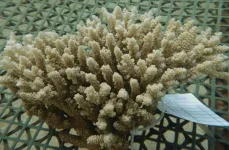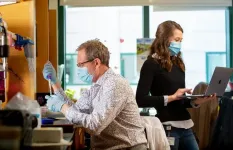(Press-News.org) Researchers have successfully grown cells from the stony coral, Acropora tenuis, in petri dishes
The cell lines were created by separating out cells from coral larvae, which then developed into eight distinct cell types
Seven out of eight cell types were stable and could grow indefinitely, remaining viable even after freezing
Some of the cell types represented endoderm-like cells, and could therefore shed light on how coral interacts with photosynthesizing algae and how bleaching occurs
The cell lines could be used in many avenues of coral cell research, including coral development, coral farming and the impact of climate change and pollution
Researchers in Japan have established sustainable cell lines in a coral, according to a study published today in Marine Biotechnology.
Seven out of eight cell cultures, seeded from the stony coral, Acropora tenuis, have continuously proliferated for over 10 months, the scientists reported.
"Establishing stable cells lines for marine organisms, especially coral, has proven very difficult in the past," said Professor Satoh, senior author of the study and head of the Marine Genomics Unit at the Okinawa Institute of Science and Technology Graduate University (OIST). "This success could prove to be a pivotal moment for gaining a deeper understanding of the biology of these vitally important animals."
Acropora tenuis belongs to the Acroporidae family, the most common type of coral found within tropical and subtropical reefs. These stony corals are fast growers and therefore play a crucial role in the structural formation of coral reefs.
However, Acroporidae corals are particularly susceptible to changes in ocean conditions, often undergoing bleaching events when temperatures soar or when oceans acidify. Establishing knowledge about the basic biology of these corals through cell lines could one day help protect them against climate change, explained Professor Satoh.
Creating the cultures
In the study, Professor Satoh worked closely with Professor Kaz Kawamura from Kochi University - an expert in developing and maintaining cell cultures of marine organisms.
Since adult coral host a wide variety of microscopic marine organisms, the group chose to try creating the cell lines from coral larvae to reduce the chances of cross-contamination. Another benefit of using larval cells was that they divide more easily than adult cells, potentially making them easier to culture.
The researchers used coral specimens in the lab to isolate both eggs and sperm and fertilize the eggs. Once the coral larvae developed, they separated the larvae into individual cells and grew them in petri dishes.
Initially, the culture attempts ended in failure. "Small bubble bodies appeared and then occupied most of the petri dish," said Professor Kaz Kawamura. "We later found that these were the fragments of dying stony coral cells."
In the second year, the group discovered that by adding a protease called plasmin to the cell culture medium, right at the beginning of the culture, they could stop the stony coral cells from dying and keep them growing.
Two to three weeks later, the larval cells developed into eight different cell types, which varied in color, form and gene activity. Seven out of the eight continued to divide indefinitely to form new coral cells.
Exploring the symbiosis integral to coral survival
One of the most exciting advancements of this study was that some of the cell lines were similar in form and gene activity to endodermal cells. The endoderm is the inner layer of cells formed about a day after the coral eggs are fertilized.
Importantly, it is the cells in the endoderm that incorporate the symbiotic algae, which photosynthesize and provide nutrients to sustain the coral.
"At this point in time, the most urgent need in coral biology is to understand the interaction between the coral animal and its photosynthetic symbiont at the cellular level, and how this relationship collapses under stress, leading to coral bleaching and death," said Professor David Miller, a leading coral biologist from James Cook University, Australia, who was not involved in the study.
He continued: "Subject to confirmation that these cells in culture represent coral endoderm, detailed molecular analyses of the coral/photosymbiont interaction would then be possible - and from this, real advances in understanding and perhaps preventing coral bleaching could be expected to flow."
For Professor Satoh, his interest is in how the photosymbiotic algae cells, which are almost as big as the larval cells, initially enter the coral.
"The algae are incorporated into the coral cells around a week after the larvae first develop," said Prof. Satoh. "But no one has yet observed this endosymbiotic event on a single-cell level before."
A new era for coral cell research
The scientists also found that the coral cell lines were still viable after being frozen with liquid nitrogen and then thawed. "This is crucial for being able to successfully supply the coral cell lines to research laboratories across the globe," said Professor Satoh.
The implications for future research using these cell lines are far-reaching, ranging from research on how single coral cells respond to pollution or higher temperatures, to studying how corals produce the calcium carbonate that builds their skeleton.
Research could also provide further insight into how corals develop, which could improve our ability to farm coral.
In future research, the team hopes to establish cells lines that are clonal, meaning every cell in the culture is genetically identical.
"This will give us a much clearer idea of exactly which coral cell types we are growing, for example gut-like cells or nerve-like cells, by looking at which genes are switched on and off in the cells," said Professor Satoh.
INFORMATION:
Researchers have developed the first LiDAR-based augmented reality head-up display for use in vehicles. Tests on a prototype version of the technology suggest that it could improve road safety by 'seeing through' objects to alert of potential hazards without distracting the driver.
The technology, developed by researchers from the University of Cambridge, the University of Oxford and University College London (UCL), is based on LiDAR (light detection and ranging), and uses LiDAR data to create ultra high-definition holographic representations of road objects which are beamed directly to the driver's eyes, instead of 2D windscreen projections used in most head-up displays.
While the technology has not yet been ...
Patients receiving an implantable cardioverter defibrillator (ICD) should be regularly screened for anxiety and depression, according to research presented at EHRA 2021, an online scientific congress of the European Society of Cardiology (ESC).1
Study author Professor Susanne Pedersen of Odense University Hospital, Denmark said: "Most patients adapt well to living with an ICD. For others it completely changes their life, with worries about shocks from the device, body image, and livelihood as some need to change their job."
Previous studies have shown ...
Management and outcomes of adults with atrial fibrillation are presented today at EHRA 2021, an online scientific congress of the European Society of Cardiology (ESC).1 The document is published in EP Europace,2 a journal of the ESC.
Atrial fibrillation is the most common heart rhythm disorder, affecting more than 40 million people globally.3 Those with the disorder have increased risks of complications including stroke, heart failure and dementia, and are twice as likely to be admitted to hospital as their peers without the condition. The economic burden of atrial fibrillation is rising, mainly due to complications and hospitalisations.4 Effective therapies ...
Sophia Antipolis - 24 April 2021: Atrial fibrillation can be detected during annual foot assessments in patients with diabetes, according to research presented today at EHRA 2021, an online scientific congress of the European Society of Cardiology (ESC).1
"In our study, one in six patients with diabetes had previously undiagnosed atrial fibrillation," said study author Dr. Ilias Kanellos of the European University of Cyprus, Nicosia. "This presents an opportunity to provide treatment to prevent subsequent strokes."
Diabetes is an independent risk factor for atrial fibrillation.2 Prevalence of the heart rhythm disorder is at least two-fold higher in patients with diabetes compared to those ...
Lung cancer is a major global cause of mortality, reportedly accounting for 1.7 million deaths each year. The most common form of lung cancer is non-small-cell lung cancer (NSCLC), and early-stage NSCLCs can often be surgically resected. Unfortunately, some patients still experience poor outcomes after surgical resection, prompting further research on the relationship between a patient's preoperative status and the likelihood of good postoperative outcomes.
Given this need for information, Dr. Shinya Tanaka from the Department of Rehabilitation and Prof. Naoki Ozeki from the ...
As an indicator and "amplifier" of global climate change, the Arctic's health and stability is the cornerstone of the stability of our climate system. It has far-reaching impacts on ecosystems, coastal resilience, and human settlements in the middle and high latitudes.
The Arctic has experienced amplified warming and extensive sea-ice retreat in recent decades. On 15 September 2020, the Arctic sea-ice extent (SIE) reached its annual minimum, which, based on data from the National Snow and Ice Data Center, was about 3.74 million km2 (1.44 million square miles). This value was about 40% less than the climate average (~6.27 million km2) during 1980-2010. It was ...
Anastasia Malashina, a doctoral student at HSE University, has proposed a new method to assess vulnerabilities in encryption systems, which is based on a brute-force search of possible options of symbol deciphering. The algorithm was also implemented in a programme, which can be used to find vulnerabilities in ciphers. The results of the study were published in a paper 'Software development for the study of natural language characteristics'.
Most of online messages are sent in encrypted form since open communication channels are not protected from data interception. Messengers, cloud services, banking systems--all of these ...
A breakthrough astrophysics code, named Octo-Tiger, simulates the evolution of self-gravitating and rotating systems of arbitrary geometry using adaptive mesh refinement and a new method to parallelize the code to achieve superior speeds.
This new code to model stellar collisions is more expeditious than the established code used for numerical simulations. The research came from a unique collaboration between experimental computer scientists and astrophysicists in the Louisiana State University Department of Physics & Astronomy, the LSU Center for Computation & Technology, Indiana University Kokomo and Macquarie University, Australia, culminating in over of a year of benchmark testing and scientific simulations, supported by multiple NSF grants, ...
Fentanyl, oxycodone, morphine--these substances are familiar to many as a source of both pain relief and the cause of a painful epidemic of addiction and death.
Scientists have attempted for years to balance the potent pain-relieving properties of opioids with their numerous negative side effects--with mostly mixed results.
Work by John Traynor, Ph.D., and Andrew Alt, Ph.D., and their team at the University of Michigan Edward F. Domino Research Center, funded by the National Institute on Drug Abuse, seeks to side-step these problems by harnessing the body's own ability to block pain.
All opioid drugs--from poppy-derived opium to heroin--work on receptors that are naturally present in the brain and elsewhere in the body. One such receptor, the mu-opioid receptor, ...
LEBANON, NH - Researchers at Dartmouth's and Dartmouth-Hitchcock's Norris Cotton Cancer Center (NCCC) hope to make estrogen therapy a more accessible treatment option for breast cancer patients who could benefit from it. Anti-estrogen treatments, which block growth signals from estrogen receptors (ER) in tumors, are effective treatments for ER+ breast cancer. But it is common for breast tumors to become resistant to anti-estrogen treatments over time. The research team, led by molecular biologist Todd Miller, PhD, and Nicole Traphagen, a PhD candidate in the Miller Laboratory, found that in mice, cycling between estrogen treatment and anti-estrogen treatment at a specific point in time can dramatically increase ...


